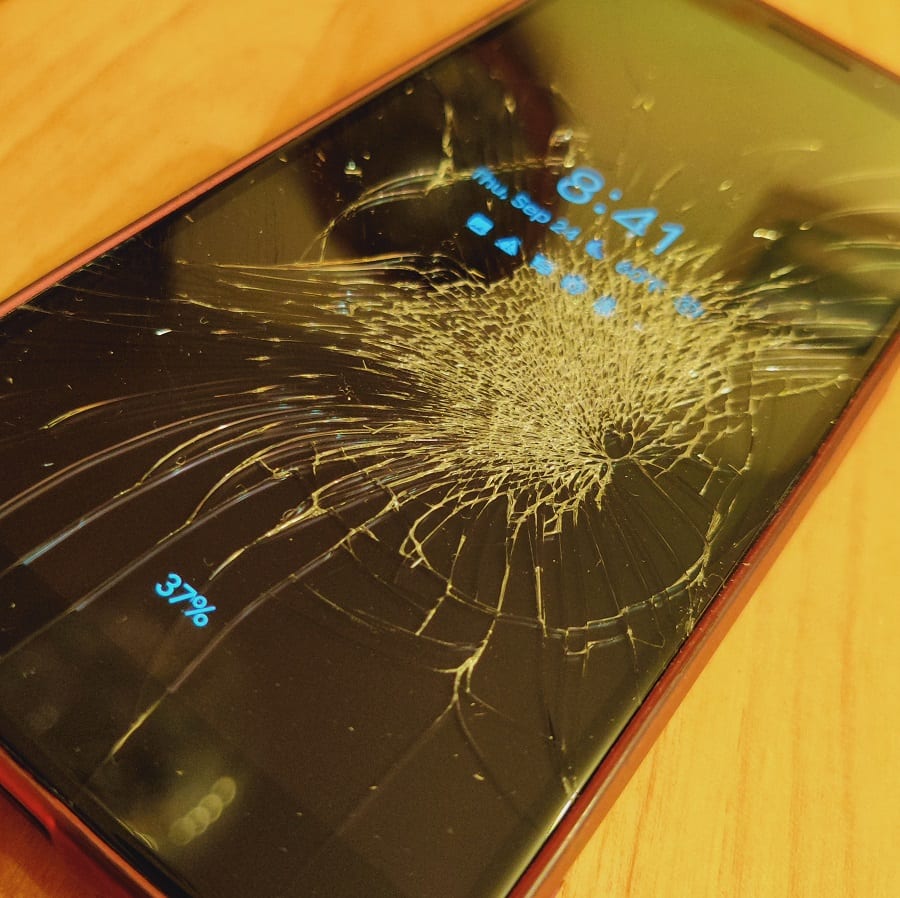These days, your cell phone may be among your most expensive possessions. Having coverage in case of damage or theft can be worthwhile for those who anticipate being prone to damaging their phone and/or who would appreciate some peace of mind about the cost of replacement in the event of damage or theft. Luckily, a number of rewards credit cards offer strong cell phone insurance coverage as part of their regular suite of benefits.
Previously, I wrote about one of my experiences using credit card cell phone insurance protection a couple of years ago. While my claim was ultimately approved, I came to the conclusion that it wasn’t really a win given that I had made a poor choice in terms of which card I used: at the time, the card I used had a large deductible and the repair cost of my phone was low. I’d have been better off self-insuring and earning more points per dollar on my bill. In the time since then, I have made a couple more claims (including one purchase protection claim and a couple of phone damage claims….we had a couple of bad years on phones). I also added a number of lines through T-Mobile promotions and I now have 9 lines on my cell phone plan. Quite a few of those lines now have late-model flagship phones on them, so the value of cell phone insurance is growing in my family with a greater likelihood of one of us breaking a phone now and then. Choosing the right card to use for my bill matters in terms of having sufficient and useful coverage, though one has to consider the value of additional rewards sacrificed.
This post includes an easy reference chart and is meant to be a quick-reference resource for what you need to know about cell phone insurance.
Credit card cell phone insurance comparison chart
| Issuer | Card | Deductible | Limits | Notes | Earn |
|---|---|---|---|---|---|
| Amex | American Express Platinum Card® & Centurion Cards | $50 | $800 / claim $1,600 / year |
Covers cracked screens but not other cosmetic damage. | 1x |
| Amex | Business Gold | $50 | $800 / claim $1,600 / year |
Covers cracked screens but not other cosmetic damage. | 4x |
| Amex | Delta Platinum & Reserve Cards | $50 | $800 / claim $1,600 / year |
Covers cracked screens but not other cosmetic damage. | 1x |
| Barclays | Aviator Business | $50 | $800 / claim $1000 / year |
Covers a max of 2 claims per year | 2x |
| Barclays | Hawaiian Business | $50 | $800 / claim $1000 / year |
Covers a max of 2 claims per year | 1x |
| Barclays | JetBlue Business | $50 | $800 / claim $1000 / year |
Covers a max of 2 claims per year. | 1x |
| Wells Fargo | Bilt Mastercard | $25 | $800 / claim 2 claims / year |
This card features World Elite Mastercard coverage. | 1x |
| Capital One | Venture X | $50 | $800 / claim 2 claims / year |
Coverage is through the same company that handles Chase coverage. | 2x |
| Capital One | Venture X Business | $50 | $800 / claim $1000 / year (up to 2 claims / year) |
Coverage is through the same company that handles Chase coverage. | 2x |
| Chase | Freedom Flex | $50 | $800 / claim $1000 / year |
Does not cover cosmetic damage that does not impact phone calls | 1x |
| Chase | Ink Business Preferred | $100 | $1000 / claim 3 claims / year |
Coverage is now up to $1,000 per claim. | 3x |
| Citi | Prestige | $50 | $1000 / claim $1500 / year |
Does not cover cosmetic damage that does not impact phone calls | 1x |
| Coastal Community | X1 | $50 | $500 / claim $1000 / year |
No annual fee card | 2x |
| Navy Federal Credit Union | Secured Card | $50 | $250 / $500 (Visa) $600 / $1K (Mastercard) |
May be a great option for a student | 1x |
| US Bank | Altitude Connect | $25 | $600 / claim $1200 / year |
Covers a max of 2 claims per year | 1x |
| US Bank | Platinum | $25 | $600 / claim $1200 / year |
This card offers no rewards. | None |
| Wells Fargo | Most consumer cards | $25 | $600 / claim $1200 / year |
This coverage even applies on a card like the Active Cash, which has no annual fee. | Varies |
| Wells Fargo | One Key cards | $25 | $1000 / claim 2 claims / year |
Includes no annual fee card. | 2x |
| World Mastercard | Some | $50 | $600 / claim $1000 / year |
Check your card number here. | |
| World Elite Mastercard | Some | $50 | $1000 / claim $1500 / year |
Check your card number here. |
For Capital One products listed on this page, some of the above benefits are provided by Visa® or Mastercard® and may vary by product. See the respective Guide to Benefits for details, as terms and exclusions apply.
Credit card cell phone insurance basics
As you can see in the chart above, there are a number of credit cards (and even debit cards and secured cards in some cases) that offer cell phone insurance, but that insurance is not created equally. The cap per claim and the cost of deductibles really vary.
Most cards require you to pay your monthly bill in full with the credit card providing coverage. You do not need to have purchased the phone itself with the credit card (in all cases of which I am aware) but rather pay the monthly service bill with it.
When coverage begins varies. With some cards (like the Chase Ink Business Preferred card), coverage begins the day after you pay your cell phone bill and continues through the end of the following calendar month. Other cards (like the US Bank Platinum card) have coverage begin on the first day of the next calendar month after you pay your bill. It is worth confirming how coverage works with your chosen card before you need to file a claim.
Will cell phone coverage apply if you only pay part of your bill with your qualifying card?
Officially, terms of cell phone insurance benefits almost all require that you pay your cell phone bill in full with the card offering coverage. Furthermore, as mentioned above, coverage on most cards begins on the 1st of the month after the month in which you pay your bill (be sure to check the terms on the specific card you intend to use as this is a generalization).
Many readers have wondered whether coverage would apply if you have used more than one card to pay the bill. For instance, the American Express Business Platinum card offers a monthly $10 credit for wireless services. Some readers have more than one Business Platinum card and may wonder whether making payments with more than one card will disqualify them from coverage. Sometimes we see other promotions pop up where you can get a better return or credit on another card.
Ultimately, whether or not your claim qualifies for coverage is going to be up to a claims adjustor / benefits administrator. In my experience, I have been covered when paying the entire amount shown on my monthly bill at the time it generates. In the past, I played that this way: I paid my bill in full with a card that offers cell phone coverage. Then, after my bill has a $0 balance, I make any additional payments. For example, imagine that my monthly cell phone bill is $100. I will auto-pay that bill with a card that offers cell phone coverage. Then, I may use a Business Platinum card and make an additional $10 payment, bringing my cell phone bill balance down to -$10. Then, when my next monthly bill generates, that -$10 balance gets carried forward and the total shown on my new monthly bill is $90 due to the negative balance carry-forward. I then pay the full amount billed to me ($90) on a credit card offering cell phone protection. Later, I repeat the $10 extra payment. I can’t guarantee that this won’t disqualify you from coverage, but I had to make a claim and I submitted my bill, which showed the total due at the top and the balance forward carry-over beneath that, and my credit card statement showing that I paid the amount billed to me and my claim was approved. Your mileage may vary.
Additional thoughts about credit card cell phone insurance
The final two entries in the chart above are for World and World Elite Mastercards. That’s because Mastercard added cell phone coverage to World and World Elite cards a couple of years ago. It wasn’t previously clear which specific cards were eligible, but now you should be able to enter your card number at https://us.mycardbenefits.com/ to see eligibility for World or World Elite benefits.
At least some cards that do offer protection do not make it particularly clear. This coverage should be found somewhere in your guide to benefits if your card offers it. That said, how many of us keep the guide to benefits handy? Some issuers make that guide to benefits available online, but not all do.
That makes this cell phone protection particularly challenging: it is possible that you have cards in your wallet that cover cell phone protection without an easy way to know it. The chart above shows cards that are known to carry coverage, but it is certainly possible that additional cards offer coverage.
Furthermore, coverage limitations vary in ways that may be significant to you. For instance, the Chase Freedom Flex card specifically excludes damage that is purely cosmetic, including cracks in the screen that are two inches long or less and do not interfere with the phone’s ability to make or receive calls. The wording there was particularly surprising: it is clear that if your phone can still make and receive calls, the damage could be deemed cosmetic even if it interferes with some apps or being able to use sections of your screen that aren’t required to make or answer calls. I don’t know how closely the benefits administrator will follow the letter of the policy as I imagine you’ll be getting your own diagnostic estimate in most cases, but it is an interesting limitation nonetheless.
If you still have the Guide to Benefits that came with your credit card, hopefully you can find cell phone protection details there. And in the case of many of the cards in the chart above, you can easily confirm coverage information on the issuer’s website.
I find it very interesting that the Navy Federal Credit Union secured credit cards offer cell phone insurance. Secured cards are for those building or rebuilding credit and therefore require a security deposit, which should make a secured card easy for almost anyone to get. I would therefore think that a Navy Federal secured card may be a great choice for a student paying for his or her own cell phone bill since I imagine they might be able to get this card even if they aren’t yet able to get some of the more rewarding cards in the list. That said, a student following Greg’s blueprint should quickly be eligible for something better.
Bottom line
Credit card cell phone insurance is a benefit that is being extended on many credit cards. This makes sense; in many cases, the most expensive / valuable item people carry with them day-to-day is their phone. Having coverage in case of damage or theft can really help ease the sting in cases where your phone is completely destroyed. On the other hand, you have to consider the deductible and coverage limits as they relate to the cost of repairing or replacing your phone — and the category bonus you may be able to trigger on a credit card that doesn’t offer cell phone insurance. Some will prefer to self-insure and use a card that earns an excellent category bonus, like the Chase Ink Cash credit card (which earns 5x on wireless services) rather than worry about insurance. It is worth running the numbers to consider how much you sacrifice in potential rewards by using a card that earns fewer points to pay your bill. On the other hand, if you have a number of expensive phones on your plan, you may be happy to trade a few extra potential points away in exchange for coverage that could save you a bundle. Indeed, over the past couple of years, I came out well ahead by being covered by my credit card.






Any chance for an updated table? Some of the cards are no longer available.
Nick, can you clarify the 4x on the Amex Business Gold in the table above — is it *only* if the cell-phone charge is one of the the top 2 categories for the month? Also, a chat agent (actually 2 of them) couldn’t clarify if the employee (AU) card qualifies also for either the 4x or the protection — meaning does AU have to pay with their card their cell-phone bill or does the main card have to be used for the main account and employee account bills? Thanks!
As a data point for Amex cell phone protection. At one point, I had 6 platinum business cards between mine and my wife’s account. I paid 10 on each of the cards and have used the Amex insurance 4 or 5 times over the past several years. Each time I have no issues with reimbursement, even though the “main” business platinum card I used for most of monthly bill was only 50 or 60% total of bill. Never a question from Amex. And their process is really very simple, I call the number they send me form in email. I fill out forms and send back bills and estimate from store in repair.
Also, Verizon Business accounts don’t give discounts for doing ach versus credit card, so easy choice for me there.
Some cell phone services are prepaid and can be monthly quarterly or annual in my case I use Mint mobile and pre-pay annually. When I was paying my annual bill back in January I checked with Amex Insurance and they confirmed that if I used my business gold card to pay that annual charge I would covered for the full year. Might be worth adding a note or confirming whether frequencies other than monthly would be covered by the various insurances.
What if the renewal is in December? Are you covered for the whole year from when you paid for the renewal?
Nick, great update to your old article, but you reference in the beginning that your thoughts have changed on this topic since your claim. What is your bottom line conclusion here? What do you currently do? I find your analysis of complicated topics one of your greatest strengths, so even if your current thoughts are not broadly applicable, your thoughts on, say what you specifically use for cell insurance and why, would be something I believe most would find helpful.
For other kinds of insurance (return protection, trip delay, etc.) Amex provides the protection itself and makes filing a claim very easy, whereas Visa and MC cards contract out their protection/insurance claims and those companies are incentivized not to pay out and filing with them is a royal pain with many hoops. Does that also apply to phone insurance? It seems that Amex uses another company to handle cell phone claims so I’m wondering if it’s still easier to actually use the insurance w Amex vs. other issuers?
Hey Nick,
Nice article, but I feel like it’s fairly dated as most major carriers require you pay through ACH to get a $10-$15/line/mo discount with them. If you pay with a credit card, you forfeit that discount, which would be massive for a family of 5 or for someone like you with 9 lines. Not sure why that wasn’t covered at all in the article.
Thanks
With T-Mobile you can enroll in ACH autopay to get the discount, but just log in each month prior to the payment posting and pay with your credit card instead. It’s a bit of a hassle, but worth it IMO to get the discount + insurance + points.
Will the same method work with At&t?
Yes this method works with at&t and has for years.
How many phone claims have you submitted and been approved?
We have Verizon and I don’t think it works the same way, but I’ll definitely do more research. It’s $15 * 5 so a $75/mo discount for our first year. I don’t want to screw that up!
I have had a contradictory experience on multiple occasions. If I pay the full amount online with a credit card at T-Mobile on the next monthly statement I do not receive the autopay discount. However, if I leave a balance of a few dollars that is deducted from either my checking or debit card then I receive the autopay discount the following month.
Hey Nick! I don’t think the Wyndham Business card includes cell phone protection anymore. As of July 1…
Correct. This was my choice until July for this reason.
Yes, that is correct. I had to switch my form of payment which was a huge bummer. The article needs to be updated. Thanks Team FM!
Thanks, fixed that!
What if you basically got your phone for free from a promo, though of course you on the hook for monthly service charges with the carrier for 2 years? If you didn’t actually pay anything for the phone, will they still reimburse you for the retail amount, for the current replacement amount, or nothing?
Read the article. It says monthly bill – not paying for the phone.
There’s some debate on whether coverage works for Prepaid plans? I have my wife and 2 daughters on Visible and have been paying their bill via Capital One Venture X. I’ve been assuming their phones are covered. Any DPs on this?
I also pre-pay annually, so have wondered the same thing?
I am a lawyer who has read the terms very carefully although I am not your lawyer and this is not legal advice. Best I can understand from the terms I’ve read (Chase and Cap One), annual payments would not have any coverage, whereas monthly payments would have coverage as long as you did not purchase the phone through the prepaid carrier.
Can you look at Wells Fargo terms and see how they compare? I’ve seen people claim that they were covered with annual plans.
US Bank changed their coverage, now a $100 deductible on the Altitude Connect’s policy. Not sure if the US Bank Platinum (no fee) has been changed yet.
Would be great if you could add which cover prepaid cell phones. Amex’s seems a fuzzy definition, but World Elite MCs (at least Citi Prestige) explicitly exclude them.
Amex business gold says 2 claims per 12 month, not $1600/year..
Based on the link that the table entry refers to…
Also does anyone know is Google Fi earns 4x?
@Nick Reyes Does the Amex Business Gold cover Google Fi? I know the wireless credits used to never credit for Google Fi, and so wondering if the 4x and cell phone insurance actually apply to Google Fi wireless on any Amex cards?
this is the most useless benefit for any card as all three major providers do not offer autopay discounts when using credit for personal accounts. I have 6 lines with Verizon so that’s $60 more I am paying each month. not sure how well works for MVNOs / prepaid service.
T-Mobile still lets you go in and make manual payments and keep the autopay discount as long as a bank account is set up for auto pay. Hopefully this continues to work for the long term.
Missing Chase Ink Business Cash
I wish Ink Cash had coverage like that. Source: https://awardwallet.com/blog/wp-content/uploads/2024/06/Ink-Benefits-2024.pdf